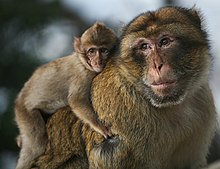Barbary ape
| Barbary macaque | |
|---|---|
 |
|
| Scientific classification | |
| Kingdom: | Animalia |
| Phylum: | Chordata |
| Class: | Mammalia |
| Order: | Primates |
| Family: | Cercopithecidae |
| Genus: | Macaca |
| Species: | M. sylvanus |
| Binomial name | |
|
Macaca sylvanus (Linnaeus, 1758) |
|
 |
|
| Geographic range; currently the Tunisian population shown on the map is extinct. | |
The Barbary macaque (Macaca sylvanus), Barbary ape, or magot is a species of macaque unique for its distribution outside Asia and for its vestigial tail. Found in the Atlas Mountains of Algeria and Morocco along with a small population that were introduced from Morocco to Gibraltar, the Barbary macaque is one of the best-known Old World monkey species.
The Barbary macaque is of particular interest because males play an atypical role in rearing young. Because of uncertain paternity, males are integral to raising all infants. Generally, Barbary macaques of all ages and sexes contribute in alloparental care of young.
Macaque diets consist primarily of plants and insects and they are found in a variety of habitats. Males live to around 25 years old while females may live up to 30 years. Besides humans, they are the only free-living primates in Europe. Although the species is commonly referred to as the "Barbary ape", the Barbary macaque is actually a true monkey. Its name refers to the Barbary Coast of North West Africa.
The Barbary macaque population of Gibraltar is the only such population outside of Northern Africa and the only population of wild monkeys in Europe. The Rock of Gibraltar is populated by approximately 230 macaques.
The monkey is yellowish-brown to grey with a lighter underside. The Barbary macaque has a mean body length of 556.8 mm (21.9 in) in females and 634.3 mm (25.0 in) in males, and mean body weight is reported to be 9.9 ± 1.03 kg (21.8 lbs) in females and 14.5 ± 1.75 kg (32.0 lbs) in males. Its face is dark pink and its tail is vestigial, measuring anywhere from 4 to 22mm. Males often have a more prominent tail. The front limbs of this monkey are longer than its hind limbs. Females are smaller than males.
...
Wikipedia

